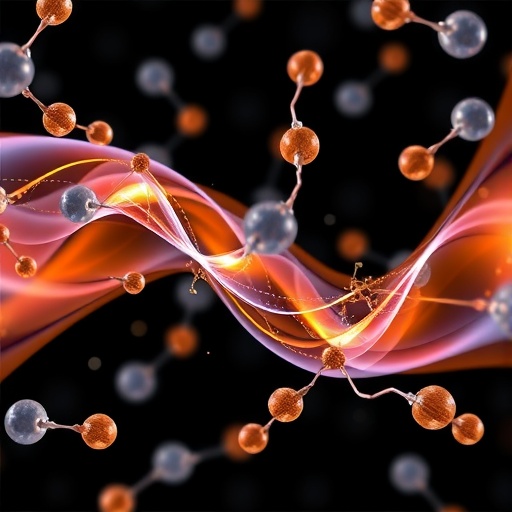In recent years, the pursuit of enantiopure compounds has emerged as a cornerstone in organic synthesis, primarily due to the critical roles that chiral molecules play in biological systems. The three-dimensional arrangement of atoms around chiral centers can dramatically influence a molecule’s interaction with biological targets, thus affecting pharmacodynamics, pharmacokinetics, and overall therapeutic efficacy. This inherent stereochemical sensitivity underscores the importance of developing novel methods to access enantioenriched molecules efficiently and sustainably. Among the burgeoning strategies, electrochemistry has gained remarkable attention, not only for its green and sustainable credential but also for its versatile capacity to manipulate molecular redox states under mild and controllable conditions.
Electrochemical organic synthesis is transforming the way chemists approach complex molecule construction. The precise control over electron flow during electrolysis allows for the generation of reactive intermediates that often evade traditional chemical routes. Recently, asymmetric electrocatalysis has surfaced as an innovative pathway to induce molecular chirality directly at the electrode surface, employing chiral catalysts to bias the formation of one enantiomer over another. Although encouraging advances have been made using chiral ligands and metal-based catalysts, the field faces inherent challenges. Many practical electrochemical transformations rely on direct electrolysis without a catalyst, making the induction of stereocontrol particularly elusive.
The role of supporting electrolytes in electrochemical reactions is often overlooked beyond their fundamental function to enhance solution conductivity and maintain charge balance. However, emerging evidence points to their significant influence over reaction kinetics and selectivity. Given their abundance in reaction media and proximity to the electrode interface, supporting electrolytes can exert subtle yet decisive effects on the reaction environment, particularly when they carry functional groups capable of interacting with reactive intermediates. This realization has driven interest in chiral supporting electrolytes as novel mediators for asymmetric electrosynthesis, a concept that remains relatively unexplored despite its promising potential.
.adsslot_nmTDvkK1XQ{ width:728px !important; height:90px !important; }
@media (max-width:1199px) { .adsslot_nmTDvkK1XQ{ width:468px !important; height:60px !important; } }
@media (max-width:767px) { .adsslot_nmTDvkK1XQ{ width:320px !important; height:50px !important; } }
ADVERTISEMENT
A groundbreaking study led by Mao, Liu, Wang, and colleagues has now harnessed the power of substoichiometric chiral phosphate salts employed as supporting electrolytes to achieve enantioenriched oxidation of racemic trivalent phosphines. Their approach represents a strategic departure from conventional asymmetric catalysis by leveraging the dual function of chiral phosphate ions: facilitating ion transport and directly influencing stereochemical outcomes at the electrode interface. This innovation not only extends the electrosynthetic toolbox but also paves the way for more sustainable and efficient asymmetric synthesis methodologies.
Central to the authors’ methodology is the dynamic kinetic resolution (DKR) mechanism that capitalizes on the fast pyramidal inversion of an anodically generated phosphoniumyl radical cation. In typical radical-radical or radical-cation processes, the fleeting nature of these intermediates often hinders stereochemical discrimination. However, phosphines exhibit a unique inversion dynamic—the pyramidal center rapidly inverts its configuration, allowing interconversion of enantiomers while the selective transformation proceeds. By tuning the electrochemical parameters and electrolyte composition, the researchers exploit this behavior to channel the reaction pathway toward the preferential formation of one enantiomer over the other.
The electrochemical cell’s interface emerges as a critical locale for enantioselectivity, where the high local concentration of chiral phosphate ions modulates the environment encountered by the phosphoniumyl radical cation during its rate-limiting nucleophilic addition step. This intimate interaction creates a chiral microenvironment that effectively discriminates between possible reaction trajectories, ultimately enhancing the enantioselective control. Importantly, this effect arises from the supporting electrolyte itself without the need for additional chiral catalysts, simplifying reaction conditions and reducing potential costs.
Mechanistically, this study deepens our understanding of how radical-ion intermediates can be manipulated stereochemically through the subtle interplay of electrostatic and stereoelectronic interactions at the electrode surface. The use of chiral anions introduces a new dimension to the design of asymmetric electrosynthetic systems, where the electrolyte is no longer a passive component but an active participant governing reaction stereodynamics. Such insights hold the promise of advancing asymmetric synthesis beyond the constraints of traditional catalyst-based systems and expanding the scope of radical-based transformations.
The implications of this work are significant for the field of asymmetric catalysis and the broader realm of organic synthesis. Beyond phosphines, the principle of using chiral supporting electrolytes could be extended to various substrates undergoing electrochemical transformations where radical or radical cation intermediates are involved. Such adaptability signifies a potentially universal strategy for inducing chirality in a range of electrochemical reactions, thereby offering a greener and more streamlined alternative to metal-based catalytic systems.
Furthermore, the sustainability aspect of electrochemical approaches offers a compelling advantage in the contemporary drive toward environmentally benign chemical manufacturing. Conventional asymmetric synthesis often relies on precious metals or stoichiometric chiral auxiliaries that can generate substantial waste and necessitate complex purification. By contrast, the electrolyte-mediated asymmetric electrosynthesis described here utilizes substoichiometric quantities of readily synthesized chiral phosphate salts, lowering both material cost and environmental impact.
Looking forward, further refinement and diversification of chiral supporting electrolytes are expected to enhance enantioselective outcomes and broaden substrate compatibility. Rational design of electrolyte structures that optimize interaction with particular intermediates, coupled with advances in electrochemical reactor engineering, might unlock unprecedented levels of stereocontrol and reaction specificity. This integrated approach could facilitate the development of next-generation asymmetric transformations that are both efficient and sustainable.
Moreover, this pioneering work bridges the gap between electrochemical methodology and stereoselective synthesis, showcasing how meticulous control over molecular interactions at electrochemical interfaces can be harnessed to solve longstanding challenges in asymmetric synthesis. It invites chemists to rethink the roles played by reaction media components and to embrace electrochemistry not only as a redox tool but as a versatile platform for stereochemical innovation.
In conclusion, the development of chiral supporting electrolytes as enantioselective mediators marks a significant milestone in the quest for sustainable and efficient asymmetric synthesis. By dynamically resolving racemic phosphines during electrochemical oxidation, the approach exemplifies how combining mechanistic insight with electrochemical principles can yield transformative synthetic methodologies. As the boundary between electrochemistry and asymmetric catalysis continues to blur, the future of enantioselective synthesis looks poised to enter a new, electrifying era.
Subject of Research: Dynamic kinetic resolution of phosphines through chiral supporting electrolytes in asymmetric electrosynthesis.
Article Title: Dynamic kinetic resolution of phosphines with chiral supporting electrolytes.
Article References:
Mao, K., Liu, C., Wang, Y. et al. Dynamic kinetic resolution of phosphines with chiral supporting electrolytes. Nature (2025). https://doi.org/10.1038/s41586-025-09238-x
Image Credits: AI Generated
Tags: asymmetric electrocatalysischallenges in electrochemical transformationschiral catalysts in electrochemistrycomplex molecule construction techniquesdynamic kinetic resolutionelectrochemical organic synthesisenantiopure compound synthesismolecular chirality inductionpharmacodynamics and pharmacokinetics of chiral moleculesreactive intermediates in electrolysisstereochemical sensitivity in drug designsustainable methods in organic chemistry





